Elaine Alys Haxton was born in Newmarket, Melbourne in 1909, the youngest of three children of David Malcom Haxton and Isobel Florence Haxton. Her older siblings being Vivian and Enid. Her family moved to Sydney in 1910. Here at the age of 14 she started training at East Sydney Technical College under Rayner Hoff. Her days were filled with drawing and sculpture, interrupted with painting activities such as preparing for Artists Balls, student exhibitions and assisting Rayner Hoff on projects such as the Sydney War Memorial in Hyde Park. An outstanding artist himself, he trained her to observe the essence of a subject rather than copy its superficial appearance and to sketch from memory after close observation of a model or scene.
To help pay for her art classes at East Sydney Technical College as a night student, Elaine did pokerwork on wooden vases and the like, with Australian motives. Later she worked at David Jones in fashion design advertisements. Elaine left David Jones to freelance painting with watercolours.
Elaine exhibited in a number of Group Art Shows Colin Simpson’s newspaper critic’s glowing article headed “Watch Miss Haxton”. Elaine sailed for England on the “Jervis Bay” in 1933 with £10 in her pocket. Elaine found work in London with J. Walter Thompson, an advertising agency. Her work included drawings in Vogue, Harper’s Bazaar, Seventeen, House and Garden, Strand Magazine and in Paris for La Fayette Galleries.
At night she studied drawing and painting at the Grosvenor School under Lain McNab. There were painting trips to France, Spain and Germany with fellow artists Brenda Cooley and John Passmore. Exhibitions in London included Elaine’s oil paintings and drawings, allowing further weekends and holidays to Belgium, Denmark, Sweden and other countries to do more paintings.
After 8 years in London, Elaine decided to return to Australia to see the family via New York. While in New York, Elaine visited friends, art galleries, theatres and travelled east to west in USA. Of New York theatre she said, “I was overcome by the lavish stage productions, but never had a thought of designing a theatre.” She left New York after six weeks, to travel alone via Laredo, Texas to Mexico by bus, where she moved around the country to study murals. Her paintings and drawings filling sketch books continuously. At Cuernavaca she stayed for a while in a motel with a perfect little studio of white-washed walls overlooking a flower drenched courtyard with a musical fountain and swimming pool.
The colours of the buildings, people flowers and marketplaces filled her paintings of the area. Murals in Mexico had a profound influence on her and later she was able to use these experiences to paint charming designs, notably the Claremont Café (1940) and La Coq D’or Restaurant, which won the Sulman Prize 1943. All the time she was abroad Elaine wrote marvellous descriptive letters to her mother and father, which included wonderful informative and colourful drawings of places she was visiting.
After about 4 months in Mexico, she left for home on the “Monterey” to see her family in Australia, intending to stay about 6 months. Weeks later, September 1939 war against Germany was declared, so Elaine remained in Australia.
The next few years were very productive. Countless principle mixed exhibitions, One Man shows, 5 murals , theatre décor and costume designs, book illustrations designing textiles for Marion Hall Best, John Kalder and Claude Alcorso.
Travelling to Merauke, New Guinea in wartime (1945) with Dutch dancers to entertain the troops as a stage manager, Elaine also designed the costumes and painted the stage scenes from long rolls of paper every night as the strong wind tore them, even so, the troops made souvenirs of them.
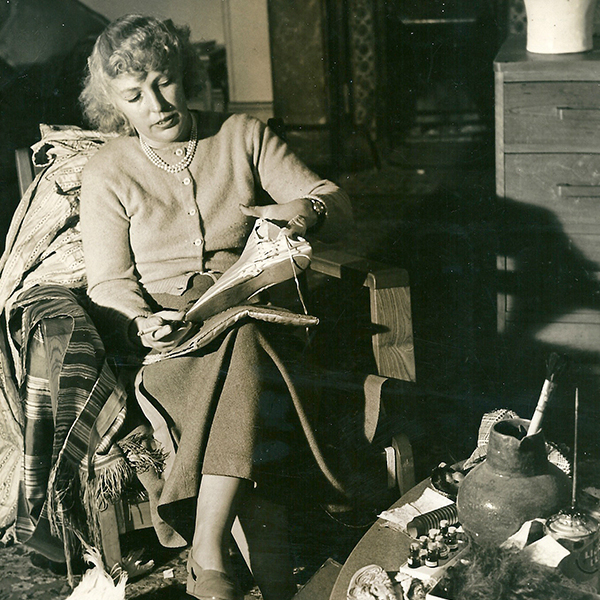
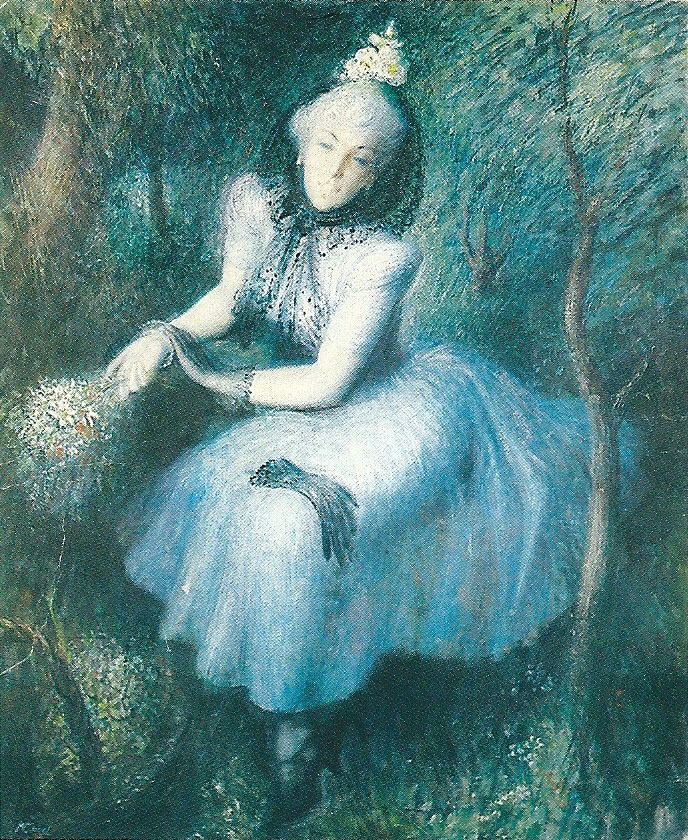
Portrait of Elaine Haxton painted by William Dorbell in 1941.
Returning to Sydney, Elaine became an important member of a fine art group of painters and friends, William Dobell, Russell Drysdale, Donald friend, Adrian Feint. In 1941 Dobell painted her portrait, which was bought at that time by Mr and Mrs Lloyd Jones.
Still painting until she left for New York in 1945, Elaine arrives on Christmas Eve and was taken to Peggy Guggenheim’s famous Christmas party by Edgar Kauffman, whom she had met during his visit to Sydney during the war. Elaine stayed for Christmas and New Year with the Kauffman family at their house, “Falling Waters” designed by Frank Lloyd Wright.
This time Elaine was in New York to study theatre design at the New School of Theatre Design. She found New York “intoxicating and the galleries, oh so exciting”. Her life was full of new paintings, new people, concerts, museums and sights. Following which Elaine initiated some internal journeys in the United States, travelling alone to Washington DC, Philadelphia and San Francisco.
In 1947 Elaine met her future husband Brigadier Richard Cunningham Foot (Dickie) when she returned to London to study and work. But times were hard in London following the war and Elaine returned to Sydney.
In 1948; Elaine rented a flat in College Street to work on a large commission. Anthony Hordens, a Sydney department store, celebrated its 125th birthday by employing Elaine and Alister Morrison, one of the finest industrial designers, to design and create their 50 big windows. It was the biggest display ever done for an Australian store. Elaine painted large backgrounds, delightful peep shows and other props, for the merchandise on display. Original sketches still survive.
Murals on Nursery walls and an outside sign for Jacaranda Cottage Hospital in NSW were completed. The P & O Steamship Company commissioned Elaine to design a series of 16 children’s menu cards and sets of playing cards for adults. The theme of the P&O pups George, Henry, Victoria and Sinbad the ships cat, all featured suitable dressed for all occasions.
A One Man Show of oils, gouache and drawings at Macquarie Galleries followed. One painting “Strange Children” was purchased by the National Art Gallery of NSW. In later years, this painting was the inspiration for a ballet by Margaret Barr for the Sydney Dance Group (1955).
Although work commitments often kept them apart, Haxton and Dickie Foot’s relationship grew. In 1949 they flew together for San Francisco, then on to New York for a few days to see friends and galleries, before flying to London. Elaine was painting and learning to drive, while Dickie attended to business at his London office. In May 1949 they took the car, a Riley packed with luggage and loaded it on loaded it on a plane to Le Trugnet in France. After five months of travel through Europe, meeting friends, Elaine drawing and painting oil sketches, they boarded a plane, car and all, for London.
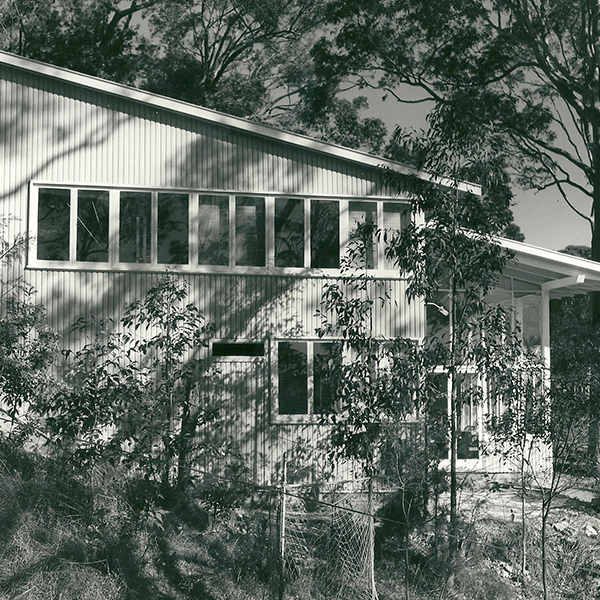
Dickie returned to Sydney while Elaine finished her committed work before returning to Sydney. Dickie purchased a large block of land with a boatshed on Pittwater. This became a living area/studio for Elaine while the house, designed by architect Arthur Baldwinson, was being built.
By now Elaine’s drawings and paintings were being purchased by the National Galleries in Australia and overseas. In 1950 Elaine produced two One Man shows, participated in a number of mixed shows including “A Collection of NSW Painters” for the Perth Art Gallery. The painters included William Dobell, Russell Drysdale, Donald Fiend, Arthur Murch, Grave Crowley, Margaret Preston and others.
The 50’s were one of Elaine’s most productive time. In designing for the theatre, not only did she design the décor and costumes but painted the backdrops. The 5 “Nutcracker” backdrops were 42 feet (12.8 metres) long by 24 feet (7.3 meters) wide and took a hectic 2 months to produce. The reviews were “perfect for the theme” delightful”, “a riot of colour and originality” etc.
Elaine and Dickie were married. The house was finished, a two-storey contemporary style, with lots of glass and light and a studio on the top floor overlooking Pittwater. Elaine painted a mermaid on the ceiling of the bathroom and another mural on a patio wall.
Still exhibiting her paintings in 1955 she completed a mural outside in the winter, which was 22 feet (6.7 meters) high and 18 feet (5.5 meters) long for St Catherine’s Girl School, Toorak, Victoria. Now on the National Trust register.
The first Cultural Delegation to China in 1956 led by Professor GP Fitzgerald, comprised academics, curators and a number of art professionals including:
- Elaine Haxton - artist
- Douglas Annand - artist
- Charles Bush - artist
- Gerald Sewers – sculptor and
- Alan Marshall – Writer
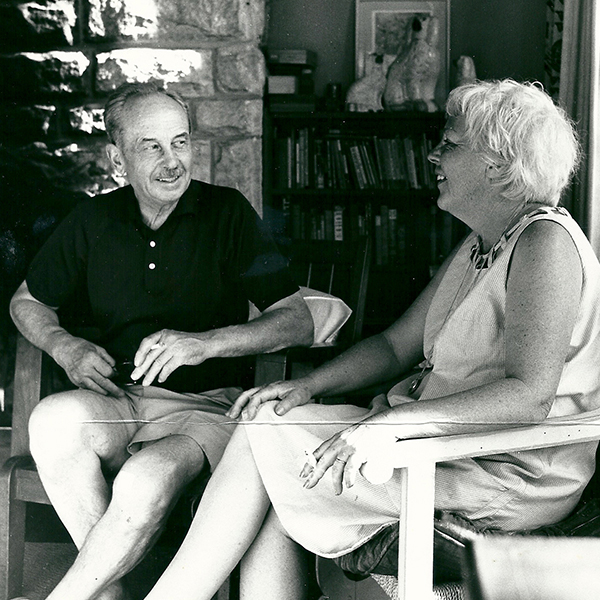
Although the tour met with political opposition in Australia, Elaine always saw the tour as cultural, not political and that her role on the mission was to learn more about Chinese visual and theatre arts. The five week visit was amazing for Elaine and she filled sketch book after sketch book, full of landscapes, people, flowers and birds etc. Elaine would later use these sketches for reference in her paintings, printing and drawings.
A number of exhibitions with Society of Artists, Society of Sculptors and Associated Macquarie Galleries and others followed. An exhibition of contemporary art called “Art in Everyday Life” organised to assist Legacy throughout Australian, invited artists to design and paint refrigerators. Elaine’s was a Greek theme designed on the front and 2 sides. It was 1961 and Elaine was on her travels again, this time for the Venetian Blind Manufactures Federation of Australia and the Women’s Day Magazine. This painting tour included 16 countries in 3 months to paint anything that interested her.
In an interview later Elaine remarked, “Of course it’s not easy to make sketches in the streets in a strange country, particularly when you don’t speak the language. People crowd around to watch you work, but long ago I learned how to beat that. I always carry a packet of sandwiches and when the crowd gets too oppressive, I pull them out and start to eat. The crowd disappears at once; anywhere people will watch you draw but I’ve not yet found a country where they will stop to watch you eat.” Elaine returned to Sydney at the end of 3 months and she then completed 32 oil paintings from her large number of sketch books.
Elaine started printmaking at the Willoughby Arts Centre in 1965 and a number of print exhibitions followed through to 1969, including the Sydney Printmakers 1967, with Elaine’s etching; etching and aquatint; open bite and aquatint on zinc.
Children’s books were illustrated, and prints were included in the Biennale di Xilografia Contemporanea in Capri, Italy, The Print Council of Australia1969 and others. Next was a trip to Hayter 17, the famous printing workshop in Paris, France. Despite the cold and wet weather, Elaine learnt a lot. It was hard work, 8am – 8pm, very cold in the studio and walking down from her hotel some distance away, to the studio did not help. Her sketch books and notebooks were filled with information, which she referred to when she returned to Sydney and continued painting and printing. Elaine went to Japan to study woodblock printing with Tomikichiro Tokuriki the famous woodblock printer.
Elaine’s husband died of a heart attack in December 1969. Although her personal writings show how difficult life was without Dickie, Haxton applied fierce focus and dedication to printmaking. More exhibitions filled her days and between 1970 – 1976 produced illustrations for 3 books.
- The Storey of China – Dr Lo Hui-Min.
- The Story of Australia – Meredith Hooper and
- The Story of Indonesia – Maslyn Williams.
The Indonesian book illustrations required her to travel to Indonesia for 2 months to gather information. In 1974 Elaine also travelled to Tahiti to paint.
In 1977 the National Gallery purchased her entire collection of stage designs (sets and costumes) also prints, etchings and woodcuts and in 1978 Adelaide University purchased 6 prints.
During the 1980s Elaine contributed to a large number of exhibitions, Solo Shows of paintings and others of prints and drawings. In 1982 the Queen Victoria Museum and Art gallery in Launceston, Tasmania, held a retrospective exhibition called Elaine Haxton, Printmaker and this was shown again in Canberra and Brisbane. Elaine’s last solo show was held at Solander Gallery in Canberra ACT in October 1985. There were 14 new oils and drawings. As usual she continued to show in multi-artist shows.
In June 1986 Elaine was awarded a Member of the Order of Australia A.M. for service to the Arts, particularly printmaking. A retrospective exhibition of Elaine’s work was held at the Hamer Mathew Gallery in Double Bay, Sydney in 1990.
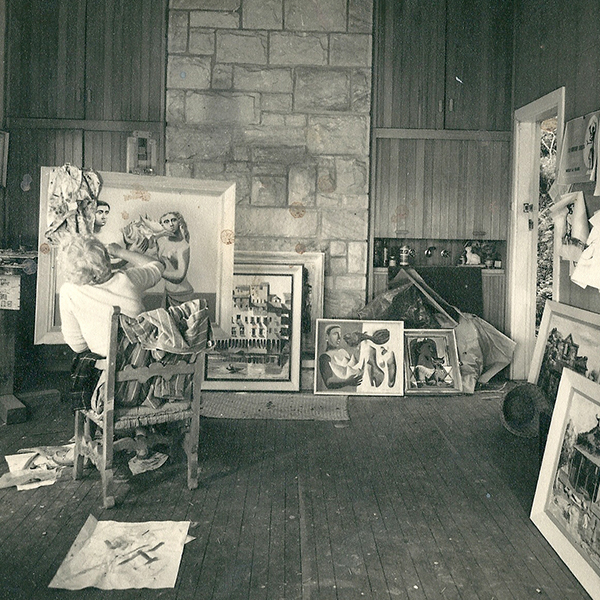
Her last years were spent in Adelaide in the care of her family and in a nursing home. Elaine died in July 1999 aged 89.
As a young child Elaine knew she would be an artist. As the years passed her love of people, the beauty of surroundings wherever she was and “the light that gives form to whatever you’re doing whether it’s a figure or a landscape”. Elaine was a prolific painter and printmaker. Her work has been seen in Australia and around the world. Her contribution to the arts has been honoured and enjoyed by people in galleries, theatres and in their own homes. What a legacy.
1Portrait of Elaine Haxton painted by William Dorbell in 1941.